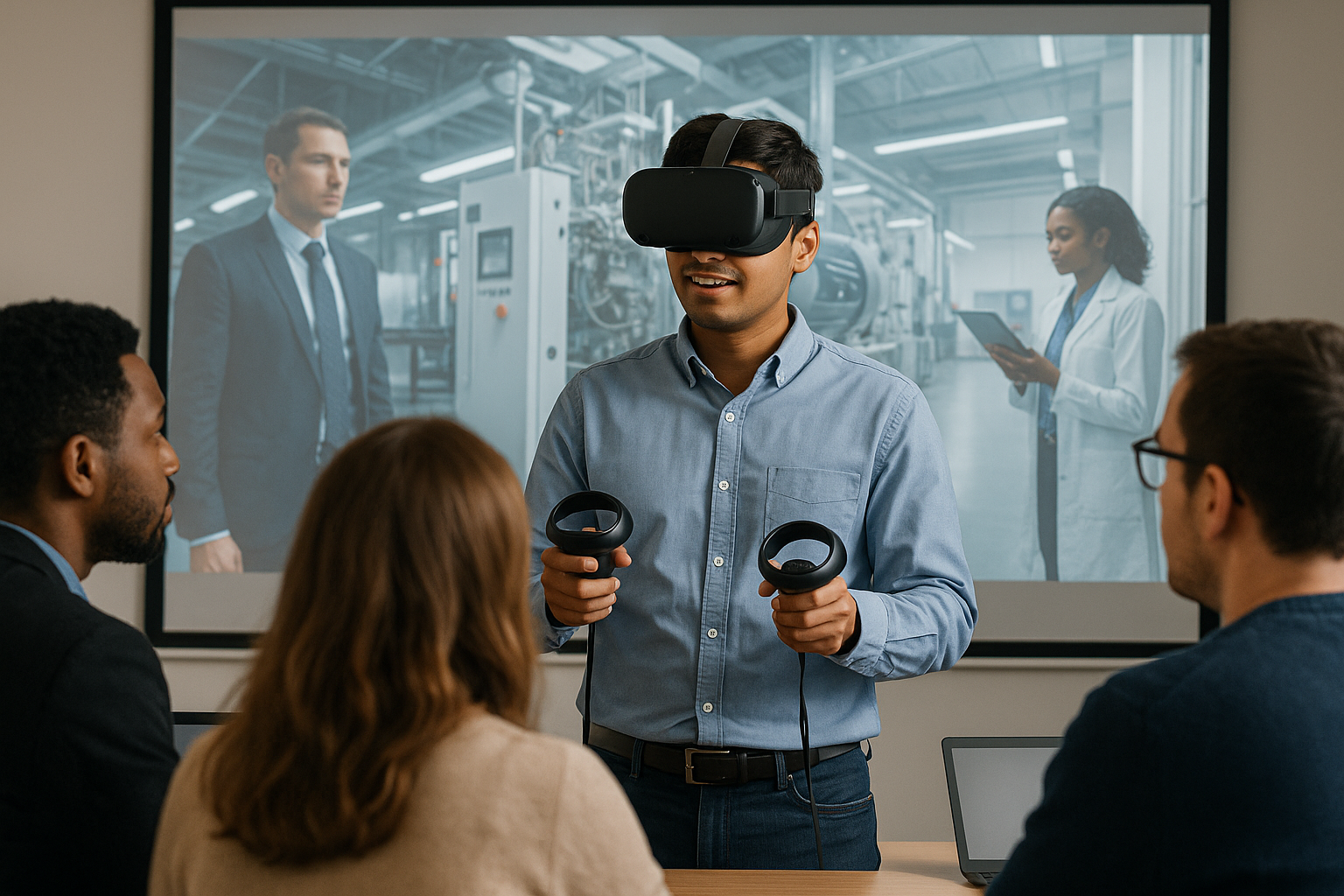Transforming Classrooms: How Virtual Reality is Reshaping Learning at Skill Bridge Learning
By Sher Ali Imtiaz, Lecturer in Business, Education, English - Skill Bridge Learning
Have you ever wished you could experience a subject rather than just read about it? Imagine learning about business or healthcare by stepping into a realistic, interactive world where your decisions carry real-time consequences. That’s the promise of Virtual Reality (VR)—a breakthrough in education that’s turning traditional learning on its head.
At Skill Bridge Learning, we're redefining how knowledge is delivered. By integrating VR into our curriculum, we’re not just teaching concepts—we’re immersing students in them. From virtual boardrooms to clinical simulations, VR is providing our learners with a hands-on understanding that books alone can't offer.

Why VR is a Game-Changer in Higher Education
VR has emerged as a powerful educational tool, especially in universities and colleges looking to enrich learning experiences. It brings subjects to life by offering simulated environments where students can actively participate and make decisions.
At Skill Bridge Learning, we’re leveraging this technology to bridge the gap between theory and practice. Whether it’s exploring humanitarian crises, business environments, or medical scenarios, VR helps students experience real-world challenges safely and vividly.
Boosting Student Engagement and Motivation
One of VR’s greatest strengths lies in how it captures attention. In an age where distractions are everywhere, holding a student’s focus is no easy task. VR changes that by turning students into participants rather than passive observers.
For instance, business students can test their decision-making skills in a simulated company environment—managing resources, leading teams, and facing the consequences of their choices in real-time. Similarly, students in health and social care can interact with virtual patients, practising diagnosis and care planning in risk-free settings.
Research shows that this kind of active involvement significantly boosts both motivation and learning outcomes (Radianti et al., 2020). At Skill Bridge Learning, we're constantly expanding these immersive experiences across disciplines to deepen comprehension and engagement.
Making Learning Experiential and Practical
Experiential learning has always been essential in higher education—but VR takes it to another level. It removes financial, geographic, and safety barriers, offering students access to experiences they might never otherwise have.
Take medical education, for example. With VR, students can practise surgeries in a fully simulated environment without risk. Engineering students can build and test virtual models without the cost of physical materials. This hands-on approach allows learners to apply theoretical concepts practically, building critical thinking and real-world problem-solving skills (Parong & Mayer, 2018).
Tailored and Inclusive Learning for All
Not every student learns the same way, and that’s where VR truly shines. This technology allows for personalised learning pathways—students can progress at their own pace and explore topics through visuals, interaction, and exploration.
A student who struggles with lectures might thrive in a visually rich, interactive VR setting. Another who learns quickly can push ahead and dive into more advanced topics. VR is also an incredible asset for inclusive learning, offering visual and audio enhancements for students with disabilities, ensuring equitable access to education (Sanchez et al., 2019).
Breaking Barriers of Location and Cost
Many educational experiences—such as fieldwork, internships, or study abroad programs—are limited by budget or distance. VR brings these opportunities to students virtually, without the need for travel or extra expense.
A marine biology student can explore underwater ecosystems without leaving the classroom. A business student can participate in virtual internships with companies around the globe. These immersive alternatives provide practical exposure that would otherwise be inaccessible (Radianti et al., 2020).
Addressing Challenges of VR in Education
Of course, introducing VR into the classroom isn't without its challenges. Equipment and software can be costly, and not all institutions have the budget to adopt the technology widely. However, as VR becomes more mainstream, prices are expected to fall, making it more accessible for schools and students alike (Hamilton et al., 2021).
Another hurdle is training educators to use VR effectively. Technology alone isn’t enough—teachers must be equipped with the skills to incorporate VR into their lessons meaningfully. Institutions must invest in staff development to fully unlock the potential of this tool.
Health considerations are also important. Some users may experience motion sickness or fatigue from extended VR use, so it’s crucial to use the technology thoughtfully and balance it with other forms of learning.
Looking Ahead: The Future of VR at Skill Bridge Learning
As technology continues to evolve, VR's impact on education will only deepen. The future could bring smarter simulations, AI-driven personalisation, and greater accessibility for learners of all abilities.
At Skill Bridge Learning, we’re excited about the role VR will play in shaping tomorrow’s professionals. Our mission is to give learners the skills they need to succeed—and immersive education is a powerful step in that direction. From classrooms to careers, we’re helping students build confidence and experience through innovation.
By embracing VR, we’re not just changing how students learn—we're transforming what’s possible in education.
References
- Freina, L., & Ott, M. (2015). A literature review on immersive virtual reality in education. The International Scientific Conference eLearning and Software for Education, 1, 133-141.
- Hamilton, D. et al. (2021). Immersive virtual reality as a pedagogical tool in education: A systematic review. Journal of Computers in Education, 8(1), 1-32.
- Liu, D., Dede, C., Huang, R., & Richards, J. (2020). Virtual, Augmented, and Mixed Realities in Education. Springer.
- Parong, J., & Mayer, R. E. (2018). Learning science in immersive virtual reality. Journal of Educational Psychology, 110(6), 785-797.
- Radianti, J. et al. (2020). Immersive virtual reality applications for higher education. Computers & Education, 147, 103778.
- Sanchez, A. V. et al. (2019). Virtual Reality and Learning: Trends and Issues. Annual Review of CyberTherapy and Telemedicine, 17, 123-127.